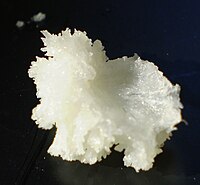This is the current revision of this page, as edited by Chem Sim 2001 (talk | contribs) at 04:58, 28 February 2024 (restored high-quality PNG drawn according to MoS). The present address (URL) is a permanent link to this version.
Revision as of 04:58, 28 February 2024 by Chem Sim 2001 (talk | contribs) (restored high-quality PNG drawn according to MoS)(diff) ← Previous revision | Latest revision (diff) | Newer revision → (diff) | |
 | |
| Names | |
|---|---|
| Preferred IUPAC name Methyl (2E)-3-phenylprop-2-enoate | |
| Other names Methyl cinnamate | |
| Identifiers | |
| CAS Number | |
| 3D model (JSmol) | |
| ChEBI | |
| ChEMBL | |
| ChemSpider | |
| ECHA InfoCard | 100.002.813 |
| EC Number |
|
| KEGG | |
| PubChem CID | |
| UNII | |
| CompTox Dashboard (EPA) | |
InChI
| |
SMILES
| |
| Properties | |
| Chemical formula | C10H10O2 |
| Molar mass | 162.188 g·mol |
| Density | 1.092 g/cm |
| Melting point | 34–38 °C (93–100 °F; 307–311 K) |
| Boiling point | 261–262 °C (502–504 °F; 534–535 K) |
| Solubility in water | Insoluble |
| Hazards | |
| GHS labelling: | |
| Pictograms | 
|
| Signal word | Warning |
| Hazard statements | H317 |
| Precautionary statements | P261, P272, P280, P302+P352, P321, P333+P313, P363, P501 |
| Flash point | > 110 °C (230 °F; 383 K) |
| Except where otherwise noted, data are given for materials in their standard state (at 25 °C , 100 kPa).
| |
Methyl cinnamate is the methyl ester of cinnamic acid and is a white or transparent solid with a strong, aromatic odor. It is found naturally in a variety of plants, including in fruits, like strawberry, and some culinary spices, such as Sichuan pepper and some varieties of basil. Eucalyptus olida has the highest known concentrations of methyl cinnamate (98%) with a 2–6% fresh weight yield in the leaf and twigs.
Methyl cinnamate is used in the flavor and perfume industries. The flavor is fruity and strawberry-like; and the odor is sweet, balsamic with fruity odor, reminiscent of cinnamon and strawberry.
It is known to attract males of various orchid bees, such as Aglae caerulea.

List of plants that contain the chemical
- Eucalyptus olida 'Strawberry Gum'
- Ocotea quixos South American (Ecuadorian) Cinnamon, Ishpingo
- Ocimum americanum cv. Purple Lovingly (Querendona Morada)
- Ocimum americanum cv. Purple Castle (Castilla Morada)
- Ocimum americanum cv. Purple Long-legged (Zancona morada)
- Ocimum americanum cv. Clove (Clavo)
- Ocimum basilicum cv. Sweet Castle (Dulce de Castilla)
- Ocimum basilicum cv. White Compact (Blanca compacta)
- Ocimum basilicum cv. large green leaves (verde des horjas grandes)
- Ocimum micranthum cv. Cinnamon (Canela)
- Ocimum minimum cv. Little Virgin (Virgen pequena)
- Ocimum minimum cv. Purple Virgin (Virgen morada)
- Ocimum sp. cv. Purple ruffle (Crespa morada)
- Ocimum sp. cv. White Ruffle (Crespa blanca)
- Stanhopea embreei, an orchid
- Vanilla
Toxicology and safety
Moderately toxic by ingestion. The oral LD50 for rats is 2610 mg/kg. It is combustible as a liquid, and when heated to decomposition it emits acrid smoke and irritating fumes.
Compendial status
See also
- Eucalyptus oil
- Ralf Sieckmann v Deutsches Patent und Markenamt, a court case concerning a company attempting to trademark the chemical compound.
References
- ^ Methyl cinnamate, at goodscents.com
- Methyl cinnamate, at Sigma-Aldrich
- "Methyl cinnamate". pubchem.ncbi.nlm.nih.gov.
- Viña, Amparo; Murillo, Elizabeth (2003). "Essential oil composition from twelve varieties of basil (Ocimum spp) grown in Colombia". Journal of the Brazilian Chemical Society. 14 (5): 744–9. doi:10.1590/S0103-50532003000500008.
- Boland DJ, Brophy JJ, House APN (1991). Eucalyptus Leaf Oils. ISBN 978-0-909605-69-8.
- Williams, N.H.; Whitten, W.M. (1983). "Orchid floral fragrances and male euglossine bees: methods and advances in the last sesquidecade". Biol. Bull. 164 (3): 355–395. doi:10.2307/1541248. JSTOR 1541248.
- Bruni, Renato; Medici, Alessandro; Andreotti, Elisa; Fantin, Carlo; Muzzoli, Mariavittoria; Dehesa, Marco; Romagnoli, Carlo; Sacchetti, Gianni (2004). "Chemical composition and biological activities of Ishpingo essential oil, a traditional Ecuadorian spice from Ocotea quixos (Lam.) Kosterm. (Lauraceae) flower calices". Food Chemistry. 85 (3): 415–21. doi:10.1016/j.foodchem.2003.07.019. hdl:11381/1449234.
- Richard J. Lewis (1989). Food Additives Handbook. Springer Science & Business Media. pp. 304–. ISBN 978-0-442-20508-9.
- Therapeutic Goods Administration (1999). "Approved Terminology for Medicines" (PDF). Archived from the original (PDF) on 22 May 2006. Retrieved 29 June 2009.